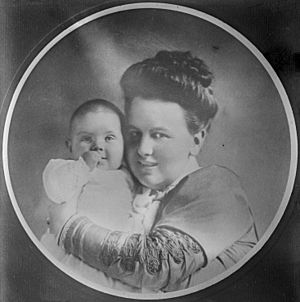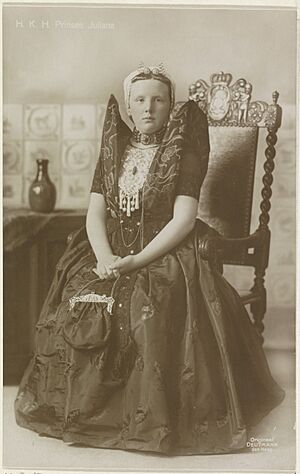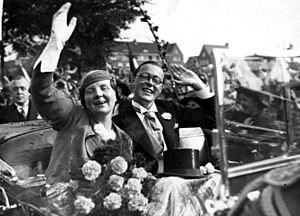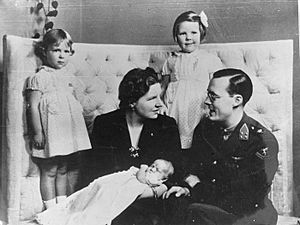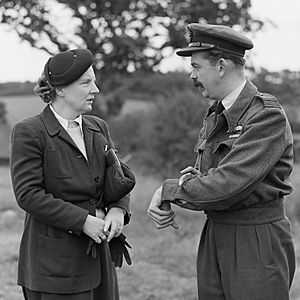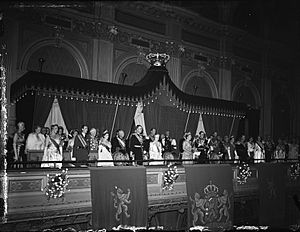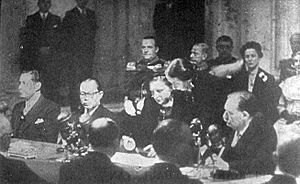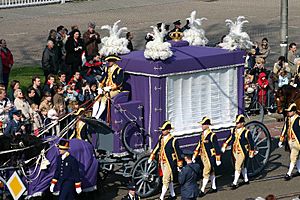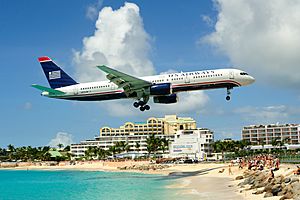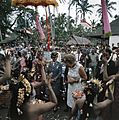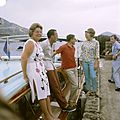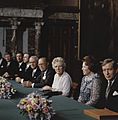Juliana of the Netherlands facts for kids
Quick facts for kids Juliana |
|||||
|---|---|---|---|---|---|
| Queen of the Netherlands | |||||
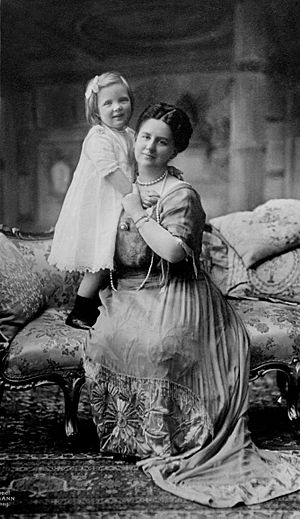
Juliana with her mother, Queen Wilhelmina, circa 1914
|
|||||
| Reign | 6 September 1948 – 30 April 1980 (31 years) | ||||
| Predecessor | Wilhelmina | ||||
| Successor | Beatrix | ||||
| Burial | 30 March 2004 Nieuwe Kerk, Delft, Netherlands |
||||
| Spouse | Bernhard of Lippe-Biesterfeld | ||||
| Issue | Beatrix of the Netherlands Princess Irene, Duchess of Parma Princess Margriet Princess Christina |
||||
|
|||||
| House | House of Orange-Nassau | ||||
| Father | Hendrik of Mecklenburg-Schwerin | ||||
| Mother | Wilhelmina of the Netherlands | ||||
Juliana (born Juliana Louise Emma Marie Wilhelmina on April 30, 1909 – died March 20, 2004) was the Queen of the Netherlands. She ruled from 1948 until she stepped down in 1980.
Juliana was the only child of Queen Wilhelmina and Prince Henry. From the moment she was born, she was expected to become queen. She received a special education at home. In 1937, she married Prince Bernhard of Lippe-Biesterfeld. They had four daughters together.
She was queen for almost 32 years. During her time as queen, countries like the Dutch East Indies (now Indonesia) and Suriname gained their independence from the Netherlands. When she passed away at 94, she was the oldest former queen in the world.
On April 30, 1980, her 71st birthday, Queen Juliana gave up her throne. Her oldest daughter, Beatrix, became the new queen. Juliana continued to support many good causes even into her eighties.
Contents
Early Life and Education
Juliana was born at Noordeinde Palace in The Hague. She was the only daughter of the Dutch Queen Wilhelmina. Her birth was very important because it meant the royal family would continue.
Juliana spent her childhood at Het Loo Palace and other royal palaces. A small school was set up at Noordeinde Palace. This way, Princess Juliana could learn with other children her age from when she was six.
The Dutch constitution said that Princess Juliana needed to be ready to rule by age 18. Because of this, her education was faster than most children's. After five years of primary school, private teachers taught her secondary subjects.
On April 30, 1927, Princess Juliana turned 18. This meant she was officially old enough to become queen if needed. A few days later, her mother made her a member of the "Council of State." This was an important advisory group.
That same year, Juliana started studying at the University of Leiden. She took classes in many subjects. These included history, law, economics, and international relations. She also learned about the cultures of Suriname and the Netherlands Antilles. In 1930, she earned a degree in international law.
Marriage and Family Life
In the 1930s, Queen Wilhelmina looked for a husband for Juliana. It was hard to find a suitable prince. The Dutch royal family was very religious.
At the 1936 Winter Olympics in Germany, Juliana met Prince Bernhard of Lippe-Biesterfeld. He was a young German nobleman. His background and religion were a good match. Queen Wilhelmina arranged their engagement. Princess Juliana truly loved Bernhard, and their love lasted their whole lives.
Queen Wilhelmina made sure everything was planned. She had lawyers write a special agreement. This agreement explained what Prince Bernhard could and could not do. It also stated how much money he would receive. Their engagement was announced on September 8, 1936.
The news of their wedding made some people in the country worried. They did not trust Germany because of Adolf Hitler. Before the wedding, Prince Bernhard became a Dutch citizen. He also changed the spelling of his German names to Dutch.
They married in The Hague on January 7, 1937. This was the same date Juliana's grandparents had married 58 years earlier. The wedding took place in the Town Hall and a church. The young couple then moved into Soestdijk Palace.
Their first daughter, Princess Beatrix, was born on January 31, 1938. Their second daughter, Princess Irene, was born on August 5, 1939.
Life During World War II
On May 12, 1940, Germany invaded the Netherlands during World War II. Prince Bernhard and Princess Juliana had to leave for the United Kingdom. Queen Wilhelmina and the Dutch government followed them. They set up a government in exile.
Juliana stayed in the UK for a month. Then she took her daughters to Ottawa, the capital of Canada. She lived there in a house called Stornoway. Her mother and husband stayed in Britain.
While in Canada, her third daughter, Princess Margriet, was born. The Canadian government made a special rule. It said Juliana's hospital room was Dutch territory. This meant Princess Margriet would be a Dutch citizen only. If not, she might not have been able to become queen later.
Canada showed its support for the Netherlands. The Canadian government flew the Dutch flag. They also played Dutch music when Princess Margriet was born. Prince Bernhard visited his family in Canada for the birth.
Juliana's kindness and Canada's warm welcome created a strong bond. This bond grew stronger when thousands of Canadian soldiers helped free the Netherlands from the Nazis in 1944 and 1945.
Juliana returned to the Netherlands on May 2, 1945. She went to Breda to help set up a temporary Dutch government. To show her thanks, she sent 100,000 tulip bulbs to Ottawa. She also gave another 20,500 bulbs the next year. She asked that some be planted at the hospital where Margriet was born. Every year, Ottawa hosts the Canadian Tulip Festival because of this gift.
After the war, Juliana helped her people. Many Dutch people had suffered from starvation during the "Hunger Winter" of 1944–1945. She was very active with the Dutch Red Cross. She also worked with the National Reconstruction organization. Her friendly and down-to-earth way made people love her. Many Dutch people soon wanted her mother to step down so Juliana could become queen.
Becoming Queen
Queen Wilhelmina's health was getting worse. It became hard for her to do her royal duties. Juliana had to take over as regent for a short time in 1947. Wilhelmina thought about stepping down, but Juliana asked her mother to stay. She wanted her mother to celebrate her 50 years on the throne in 1950. However, Wilhelmina had to give her duties to Juliana again in May 1948.
The independence of Indonesia was a big event. It was once a Dutch colony. Over 150,000 Dutch soldiers were there. Losing this colony was seen as a big economic challenge for the Netherlands. With this change, Queen Wilhelmina announced she would step down. She did so on September 4, 1948. Two days later, Juliana was officially sworn in as queen. This ceremony took place in the Nieuwe Kerk in Amsterdam. She became the 12th ruler from the House of Orange.
On December 27, 1949, Queen Juliana signed the papers. These papers recognized Indonesia's independence from the Netherlands. She became the "Head of the Union" for the Netherlands-Indonesian Union.
Queen Juliana tried to connect with her people. She often dressed like an ordinary Dutch woman. She preferred to be called "Mevrouw" (Dutch for "Mrs.") instead of "Majesty." She also enjoyed riding her bicycle for exercise.
Even though she was down-to-earth, the Dutch royal court was still grand. There were fancy uniforms, gilded carriages, and lavish parties. But the queen also visited towns and schools without notice.
Her honest and direct way of speaking made her a powerful public speaker. On the world stage, Queen Juliana cared deeply about problems in developing countries. She also focused on helping refugees and children.
Later Life and Passing
From the mid-1990s, Juliana's health slowly declined. She had trouble remembering things. Because of this, she did not appear in public after that time. Her doctors made sure she had 24-hour care. In 2001, Prince Bernhard said in an interview that the former Queen could no longer recognize her family. He said she had been suffering from Alzheimer's disease for several years.
Juliana passed away peacefully in her sleep on March 20, 2004. She was at Soestdijk Palace in Baarn. She died from problems related to pneumonia, just weeks before her 95th birthday. On March 30, 2004, she was buried next to her mother. This was in the royal vaults under the Nieuwe Kerk in Delft. Her husband, Prince Bernhard, died eight months later and was buried next to her.
In 2009, an exhibition was held at the Het Loo Palace. It showed portraits of Juliana and items from her life. This marked 100 years since her birth.
Legacy and Tributes
Many places and things are named after Queen Juliana:
- A small village near Den Helder is called Julianadorp. It was named after her shortly after her birth.
- Princess Juliana Park in Ottawa, Canada, is named in her honor.
- The Princess Juliana International Airport in St. Maarten carries her name.
- The Queen Juliana Bridge in Willemstad, Curaçao, is also named after her.
- Even an asteroid in space, 816 Juliana, is named after her.
Honours and Awards
Queen Juliana received many important honours and awards from the Netherlands and other countries. These awards recognized her service and dedication.
She was the Grand Master of several Dutch orders, like the Military William Order. She also received top honours from countries around the world, such as the Legion of Honour from France and the Order of the Garter from the United Kingdom.
She also received special awards for her work, including the Nansen Refugee Award from the United Nations.
Images for kids
-
Queen Juliana with Brazilian President Juscelino Kubitschek at Soestdijk Palace, 1956
-
Reception of Queen Juliana in Bali, September 1971. On the left the ambassador's wife, Mrs. Scheltema. In the middle adjutant Louise Elisabeth Coldenhoff of the Indonesian Navy
See also
 In Spanish: Juliana de los Países Bajos para niños
In Spanish: Juliana de los Países Bajos para niños


